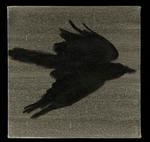Where is the White Crow?
Lam Tung-pang
林東鵬
Production date
2009-2010
Object Detail
Media
acrylic and ink on canvas
Measurements
365 parts, each 30 x 30 cm
Notes
An old Chinese saying, ‘In the whole world, all crows are black’, means that corruption, graft and nepotism are the same the world over. The intelligence of the crow is legendary across many cultures. In Tibet, the bird was traditionally associated with a positive life force and the dharma, representing cosmic law and order. In Chinese eyes, however, the crow is generally regarded as a malevolent bird that brings bad luck, a harbinger of doom, a trickster and deceiver. In Lam Tung-pang’s installation of three hundred and sixty-five paintings, Where is the White Crow? (2009 – 2010), the artist uses this omen of ill fortune to reflect on his life in Hong Kong. From the window of his studio, he could see the mountainside beyond the urban collage of crowded buildings, and the sky above them. Water and mountains are a constant presence in Hong Kong, despite the rush and bustle of one of the most densely populated places on the planet. Watching birds wheeling and drifting above the green mountains, Lam remembered the Chinese proverb and decided to use the crow as a metaphor.
Working on canvas (rather than his usual plywood) in order to begin with a white ground, Lam Tung-pang decided to paint one black crow every day for a year, on panels that each measure a square foot. This measurement is how real estate is advertised and sold in Hong Kong, a city becoming so expensive that many of its citizens are forced to live in tiny, cramped spaces. Lam was feeling uncertain about his future at that time, and the small size of each painting represents his sense of frustration and claustrophobia. He sourced photographs of crows in flight from the internet, and created a book of bird images that became his inspiration. Each day, taking up brush and black ink, Lam Tung-pang quickly painted one bird. Like the literati painters and calligraphers whose apparently spontaneous brush strokes were the result of thousands of hours of practice, Lam saw his quick expressive paintings as similarly representing thousands of hours of experience: it became a cathartic diary, day after day in one year of the artist’s life.
Working on canvas (rather than his usual plywood) in order to begin with a white ground, Lam Tung-pang decided to paint one black crow every day for a year, on panels that each measure a square foot. This measurement is how real estate is advertised and sold in Hong Kong, a city becoming so expensive that many of its citizens are forced to live in tiny, cramped spaces. Lam was feeling uncertain about his future at that time, and the small size of each painting represents his sense of frustration and claustrophobia. He sourced photographs of crows in flight from the internet, and created a book of bird images that became his inspiration. Each day, taking up brush and black ink, Lam Tung-pang quickly painted one bird. Like the literati painters and calligraphers whose apparently spontaneous brush strokes were the result of thousands of hours of practice, Lam saw his quick expressive paintings as similarly representing thousands of hours of experience: it became a cathartic diary, day after day in one year of the artist’s life.
Accession number
2014.176

